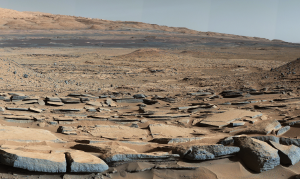Blog
Finding Fossils
on the
Surface of Mars
4 June 2018
 NASA/JPL-Caltech/MSSS
NASA/JPL-Caltech/MSSSFossils can be found all across the Earth. The fossilized bones and shells of ancient organisms has helped us understand the evolution and history of life on Earth. While fossils are relatively common, not every organism that dies will fossilize. Typically a fossil is formed when an organism dies in mud or silt. The soft tissue decays, but as the sediment hardens into rock, minerals can seep into the bones and shells creating a fossil. Since Earth has always been a wet dynamic world, we have a rich fossil record spanning billions of years. In principle fossils could form on any planet with water and life. There could be distant exoplanets with a rich fossil history. But there could also be fossils on Mars.
There have been several attempts to find life on Mars. So far we’ve found tantalizing clues, but no clear evidence of Martian life. We know the surface of Mars is dry, cold, and baked in ultraviolet radiation, which is quite hostile to life. But early Mars was very different. It was a warm, wet world with great seas. A few billion years ago, Mars was as well suited for life as Earth, and it is possible life formed there just as it formed on Earth. That wet environment would also make fossils possible. If fossils formed on Mars, we should be able to find them even today.
The key is to know where to look. Recently a team looked at looked at this question, and came up with several suggestions.1 While we know the location of several ancient dried lakes and river beds on Mars where fossils might have formed, the key is to ensure that they could hold evidence of small microorganisms. We aren’t likely to find skeletons or evidence of larger creatures, since Mars was not wet long enough for them to evolve. Any fossils formed would also have to withstand the harsh environment of modern Mars. The team found the most likely fossils could be found in mud sediments rich in iron and silicates, so these should be prioritized in future missions.
Of course, this is based on the idea that fossils on Mars would form in a similar way to those on Earth. While some similarities would certainly exist, the chemistry and history of Mars is different from Earth, and that might effect the way organisms fossilize. So another area of research would be to study just how fossilization occurs, and how it might be affected by the unique history of Mars.
McMahon, S., et al. “A Field Guide to Finding Fossils on Mars.” Journal of Geophysical Research: Planets (2018). ↩︎